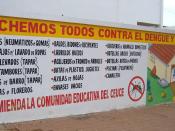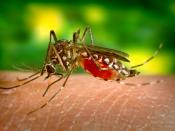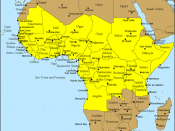Yellow Fever
Etiologic Agent
Yellow fever is caused by an arbovirus, a small virus which belongs to the flavivirus group, which is transmitted by the bite of a mosquito. Humans and monkeys are the primary animals to be infected and are both hosts in the transmission cycle. Several different species of the Aedes and Haemogogus mosquitoes transmit this virus. They are found near houses, jungles, and a combination of both environments.
Characteristics of Agent
Yellow fever is a viral disease that has been responsible for large epidemics in both Africa and South America. The World Health Organization has estimated that a total of 200,000 cases of yellow fever occur each year, with 30,000 deaths. There are three general types of the transmission cycle of yellow fever. Sylvatic or jungle yellow fever occurs in the rainforests. Infected mosquitoes bite the monkeys, and then the monkeys infest other mosquitoes that feed on them, transmitting it to humans by a human being bit by that same mosquito.
In intermediate yellow fever small scale epidemics occur in the humid or semi-humid savannahs of Africa. This is transmitted in the same basic way that jungle yellow fever occurs. Finally the largest epidemics can occur with urban yellow fever. Domestic mosquitoes carry the virus from person to person; monkeys are not involved in the process at all. These outbreaks spread outward from one source to another and usually cover large areas.
Pathogenicity
Yellow fever is most difficult to recognize in the early stages. It can be easily confused with malaria, typhoid, rickettsial disease, hemorrhagic fevers, arboviral infections, leptospirosis, viral hepatitis and poisoning because they present the same basic symptoms. A laboratory analysis is needed to confirm a suspected case. These blood tests can detect the yellow fever antibodies that the body produces in response to the...


